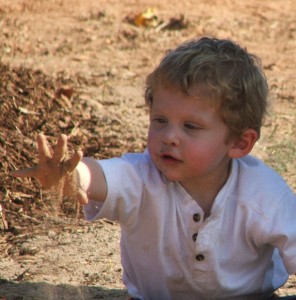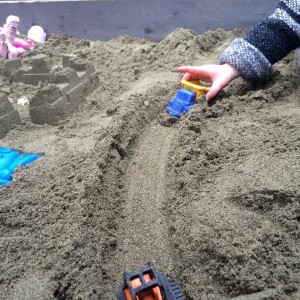To a child, the sandbox, a pile of sand, or an entire beach all offer unlimited opportunities for play and sand play is another way to go wild for nature. As their hands and bodies touch the earth, their imaginations can go far beyond.
 Sand play is quite definitely sensory. Our entire bodies can feel the texture of the sand. On the beach sand between the toes feels inviting and relaxing but inside a sock or shoe, it’s most uncomfortable. Sand is light enough to fly thru the air but feels heavy when feet and legs and buried underneath. Although sand is only one basic color, there is still lots to see. There is no shape to sand although there are different levels and contours. Sand itself doesn’t have an odor for human noses and I’m guessing it doesn’t have much flavor but it does have sounds when pouring, digging, and dumping.
Sand play is quite definitely sensory. Our entire bodies can feel the texture of the sand. On the beach sand between the toes feels inviting and relaxing but inside a sock or shoe, it’s most uncomfortable. Sand is light enough to fly thru the air but feels heavy when feet and legs and buried underneath. Although sand is only one basic color, there is still lots to see. There is no shape to sand although there are different levels and contours. Sand itself doesn’t have an odor for human noses and I’m guessing it doesn’t have much flavor but it does have sounds when pouring, digging, and dumping.
Besides the sensory aspect to sand, there is an exploratory one. Children are free to create. The only limitations are the ones that come with sand. Sand can only be piled so high unless it has something to hold it. It forms a cone all by itself but it can be molded and shaped. Children discover these sand-rules all by themselves as the engage in sand play
 Stephen Moss, a lifelong naturalist and father to five children says, “Nature is a tool to get children to experience not just the wider world, but themselves.” During sand play, children find out somethings they can and can’t do. They learn more about their own senses and their own feelings. Children might get frustrated when they can’t do something the way they want, like make the sand stay in tall, tall pile. They figure out that in order to enjoy the sand, they need to let go of some of their wants. Not only are they connecting to nature, they are also connecting to their selves.
Stephen Moss, a lifelong naturalist and father to five children says, “Nature is a tool to get children to experience not just the wider world, but themselves.” During sand play, children find out somethings they can and can’t do. They learn more about their own senses and their own feelings. Children might get frustrated when they can’t do something the way they want, like make the sand stay in tall, tall pile. They figure out that in order to enjoy the sand, they need to let go of some of their wants. Not only are they connecting to nature, they are also connecting to their selves.
For a play-of-the-day, can your child go wild for nature with sand play?
(P.S. Pinterest is sort of 123kindergarten’s sandbox.)
